George Shearings five Snader telescription performances were included in the compilations The Snader Telescriptions: The Small Jazz Groups (1988) on which it closed the 49 minutes of telescriptions, with many other great performances.
They can also be found on Swing Era: George Shearing (2003), included in an hour & a half of telescriptions & clips. The individual telescriptions are often dated 1951 in reference books, with Swedish Pastry sometimes dated 1952, but the copyright date on the orignial title cards is 1950, & they were all filmed at the same time.
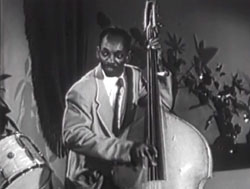 The Snader telescription Move (1950) features the George Shearing Quintet. This is an integrated band, with black drummer & bass man, respectively John Levy who was also the quintet's road manager, & Denzil Best, who wrote the bepob classic "Move" for George. The Snader telescription Move (1950) features the George Shearing Quintet. This is an integrated band, with black drummer & bass man, respectively John Levy who was also the quintet's road manager, & Denzil Best, who wrote the bepob classic "Move" for George.
These two black guys also worked with such great singers as Billie Holiday. The white guys did duty on vibraphone, guitar, & piano. When the quintet was in its heyday in the early '50s, it was still surprisingly rare to see a completely integrated band, the rule of the Jim Crow years being segregation.
The pianist bobs his head around & wears dark, dark glasses, classic postures for a blind guy. That's George, who was born blind. He's being a mite manic as his hands speed over the keys in a jazzy instrumental that does indeed move.
These guys were one of best club bands of the early '50s. In years when the Big Bands were fading & it was harder & harder to sustain a large band, many slimmed down for the quintet.
Guitarist & vibraphone get solos though George is featured primarily. The camera gives us great portraits of the drummer & bassist but sound-wise they have no solos, they just keep the beat at top speed.
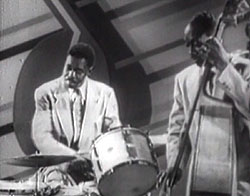 Another Snader telescription for the George Shearing Quintet is I'll Be Around (1950), written by Alec Wilder in 1942.
Another Snader telescription for the George Shearing Quintet is I'll Be Around (1950), written by Alec Wilder in 1942.
George also recorded this standard with Peggy Lee, who was a close friend of the composer. But for all the Snaders, we get only instrumentals, no vocals.
George in his shades rocks blindly at his piano. The quintet is in the exact positions as for the other Snaders, all filmed on the same day.
A simple arrangement well performed, it's a slow romantic piece, verging into exotica or tropical, again featuring mainly George's piano playing.
Though we can see the vibraphone being played, it's not registering, so we get mainly the piano over the slap base & drums played with brushes.
George was born in England & grew up working class. His father delivered coal. His mother cleaned train cars. He studied classical music & was offered scholarships, but preferred to start playing in local pubs to further schooling.
He eventually joined an "all blind band" with influences of Teddy Wilson & Fats Waller, then moved on to better established bands where his unique & harmonically complex piano style got him a lot more attention than is typical of "the pianist in the band."
He moved to America in 1947 & quickly got work with his sharp blend of be-bop & classical. In 1949 he founded his Quintet, which initially had Marjorie Hyams on vibraphone but she too soon retired & was replaced by Joe Roland by the time the quintet made their three-minute Snader films. Chuck Wayne (guitar), John Levy (bass) and Denzil Best (drums) filled out the group.
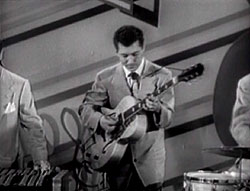 Conception (1950) opens with a close-up of George Shearing's tapping shoe under the piano, the other shoe on the foot-petals. These live recordings rarely do anything fancy with the camera, & a close-up of feet is about as clever as they get visually. Conception (1950) opens with a close-up of George Shearing's tapping shoe under the piano, the other shoe on the foot-petals. These live recordings rarely do anything fancy with the camera, & a close-up of feet is about as clever as they get visually.
Jump-cut to his swift hands on the keys. Then to the entirety of the Shearing Quartet. We can hear the vibraphone clearly this time.
As usual, George up front at piano gets star treatment as lead performer, the one drawback to these Snader telescriptions being George's error of never fully highlighting his brilliant side-men.
It's a swift jazz piece not as good as Move but a quality arrangement for piano. The vibraphone does get it's solo followed by the electric guitar solo, but very soon back to George's hands. His classical training is evident in the close just as the screen goes black.
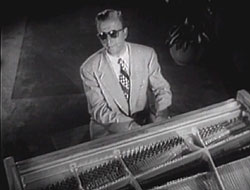 A little swing tune gives the George Shearing Quintet less reach than average, but it's a nice simple piece, I'll Never Smile Again (1950). This sweet standard was written by Ruth Lowe in 1939, & was a huge hit for the Tommy Dorsey Orchestra, the number one single by June 1940 according to Billboard Magazine.
A little swing tune gives the George Shearing Quintet less reach than average, but it's a nice simple piece, I'll Never Smile Again (1950). This sweet standard was written by Ruth Lowe in 1939, & was a huge hit for the Tommy Dorsey Orchestra, the number one single by June 1940 according to Billboard Magazine.
George's version opens with a camera angle from above, showing part of the inside of the piano, a small effort to give this telescription at least a moment that looks different from the other short films in the series.
Again the vibraphone seems not really to be miked & the guitar also fails to come through, so it's mainly George's piano plus a beat heard from the double-bass & the brushes rubbing on the drum head.
After about a minute, George breaks from the standard swing arrangement & goes into bebop. It's obvious the vibraphone & guitar are doing something & too bad they can't be heard, but it's a good sound sound even without all the instruments registering, as George is assuredly one of the greats of the time.
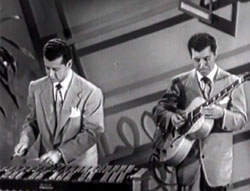 For the second time one of the telescriptions opens up on George's tapping feet under the piano, this time for the oddly titled Swedish Pastry (1950), a swift jazz piece played in a striking bebop fashion.
For the second time one of the telescriptions opens up on George's tapping feet under the piano, this time for the oddly titled Swedish Pastry (1950), a swift jazz piece played in a striking bebop fashion.
The number was composed by Barney Kessel, who recorded it himself in 1947 together with Stan Hasselgard on clarinet.
Barney was one of the greatest jazz electric guitarists, so one would expect Chuck Wayne to have a bit of focus in the Shearing arrangement. And Wayne indeed gets some fine moments to shine, though he's not "starring" in the piece.
We can also hear Joe Roland's vibraphone nicely this time, with a fine solo moment, even if once again, as always, the bulk of the arrangement is mostly all about George.
When George broke up his quintent in the 1970s he said it was because he'd become predictable. In five telescriptions he's actually already predictable. But extremely good, so why complain.
copyright © by Paghat the Ratgirl
|
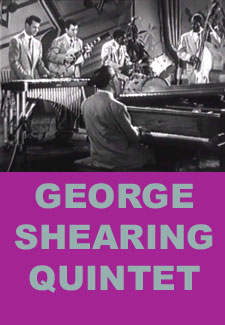
 The Snader telescription Move (1950) features the George Shearing Quintet. This is an integrated band, with black drummer & bass man, respectively John Levy who was also the quintet's road manager, & Denzil Best, who wrote the bepob classic "Move" for George.
The Snader telescription Move (1950) features the George Shearing Quintet. This is an integrated band, with black drummer & bass man, respectively John Levy who was also the quintet's road manager, & Denzil Best, who wrote the bepob classic "Move" for George.
 Conception (1950) opens with a close-up of George Shearing's tapping shoe under the piano, the other shoe on the foot-petals. These live recordings rarely do anything fancy with the camera, & a close-up of feet is about as clever as they get visually.
Conception (1950) opens with a close-up of George Shearing's tapping shoe under the piano, the other shoe on the foot-petals. These live recordings rarely do anything fancy with the camera, & a close-up of feet is about as clever as they get visually.
